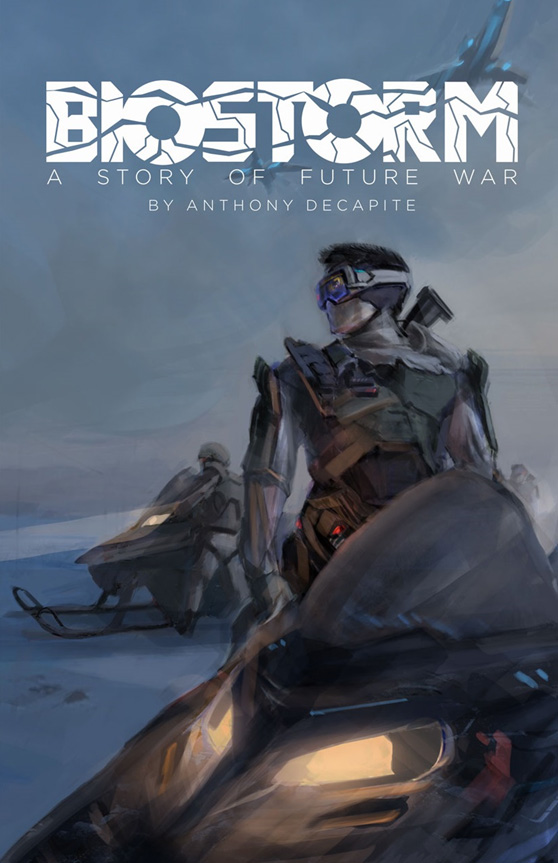
Biostorm: A Story of Future War
Anthony DeCapite
This article is the latest addition to the U.S. Army TRADOC G2 Mad Scientist Initiative’s Future of Warfare 2030-2050 project at Small Wars Journal. Based on ideas developed in the SciTech Futures Technology Foresight Game: Bioconvergence and the Soldier of 2050, which was conducted by the University of Southern California’s Institute for Creative Technologies. Supported by the SciTech Futures Technology Effort under the office of the Deputy Assistant Secretary of the Army (Research & Technology). The views and opinions of authors expressed herein do not necessarily state or reflect official views or policies of the United States Army.
THE YEAR IS 2042...
The US and its remaining NATO allies are engaged in a limited war with the Mektigfolk, an ultra-nationalist techno-state that emerged from northern Europe during the reactionary upheavals that swept the continent in 2026.
The US has deployed a Joint Task Force to protect crucial rare-earth mining operations on a vast ice sheet in the Barents Sea.
Captain Steven Park and his infantry company, of the 10th Mountain Division, must protect an engineering detachment that will build a Combat Outpost around the Strand, a deep-sea mining facility.
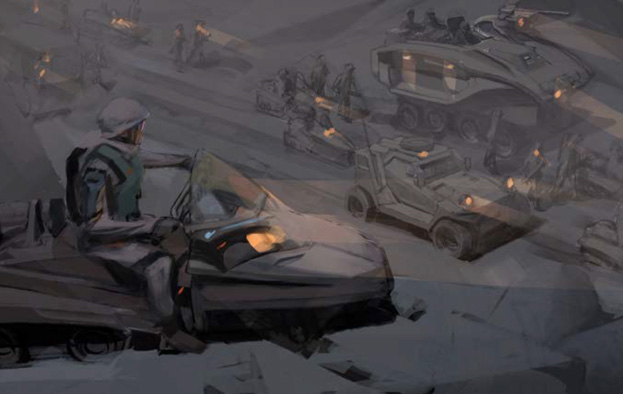
It was good to be outside the wire. As Alpha Company commander, Captain Steven Park had been stuck within the confines of FOB Nordau for weeks while his Platoon Leaders got to go tramping around the ice shelf, conducting recon and planting sensors.
Not today. Nordau was 150 klicks behind them. Park had his company in a wedge formation, protecting the elements of 7th Engineer Battalion that followed them in a column. Their mission: to provide security for 7th Engineers while they built a Combat Outpost at their destination, a mining facility known as the Strand.
The Strand perched on the edge of the shelf, overlooking the Barents Sea. Right in the Mektig’s backyard. Beneath the facility was a treasure trove of a Rare Earth Element crucial in military guidance-and-control systems. With China throttling the global REE market, securing viable sources had become a NATO priority.i
Park couldn’t care less about REEs. He had trained host nation security forces and got in firefights with irregular fighters, but he had never faced a near-peer threat before. America had not done so in almost a century. Park was eager to prove his company was up to the task.
The long distance and extreme cold of the mission meant that every one of his Soldiers was packed in a Stryker, JLTV, or mounted on a snowmobile. The boys and girls of the 7th filled bulldozers, heavy equipment transports, and cargo trucks. From the view of their ISR quadcopter drone – the ‘Buzzard’ – the mass of vehicles looked like a deformed caterpillar inching across a white desert.
Park had shunned his JLTV seat and chosen a snowmobile, wanting to brave the same cold that his rifle squads faced here at the head of the caterpillar. There had been no sign of enemies for the entire movement, though their Buzzard, with its array of sensors, had detected a group of sea lions two klicks from the right flank. The latest intel said the nearest Mektig unit was 200 klicks southeast, moving to fortify Franz Josef.
“Six, this is One-Six.” Lieutenant Rowe, leader of First Platoon, was on the hook for him. “Buzzard’s detecting multiple objects descending toward us. Got the Javelins on it.”
“Copy.” Park switched to the formation-wide channel: “Company, prepare for air-to-surface attack.”
The formation dispersed and exposed Soldiers piled into skinned vehicles. Park jumped off his snowmobile and SPC Logan helped him into a Stryker.
Park turned on the Augmented Reality display built into his HUD goggles, and a Picture-In-Picture materialized in the top right corner of his vision. It showed a computerized dome view of the airspace over their formation, with metadata: 24 spherical objects dropping like stones.ii Park switched to optical view and zoomed in – softball-sized aluminum bomblets.
“Too small for Javelin lock,” LT Rowe said. “Incoming!”
“Incoming!” The shout was repeated over the hook and echoed across the icy landscape.
Pff-pff-pff! Instead of exploding, the bomblets impacted in the snow. Then, there was a hiss, and green-brown mist erupted from the bomblets, enveloping the entire formation.
Shouts of “Gas-gas-gas!” crackled over the hook and Park’s Soldiers took out and put on their gas masks. Park tightened the straps on his own, securing it. Still, his nostrils filled with a rotten egg smell. Park felt no effects, and the bio-feedback readout in his HUD showed his Soldiers breathing normally. It wasn’t a chemical attack, at least not the kind Park feared.
First, 7th Engineer’s dozer ground to a halt in the ice. Then, the Stryker he was in stopped.
“Keep moving. We need to clear this gas.” Park ordered.
“It’s not me, sir! The engine died.” The driver replied.
Park heard a squeal of brakes, then there was a horrendous crunch of metal as something slammed into them, knocking Park’s helmeted head into SPC Logan’s.
Park used his AR PIP to get the bird’s eye view. A heavy equipment transport had slammed into his Stryker, and all around, vehicles were slipping and sliding to a stop.
“That gas attack disabled all the vehicles!”
“Prepare for contact,” Park said.
Moments later, the pops of small-arms fire fulfilled his prophecy, echoing from the rear.
“Contact rear!” In his HUD’s PIP, Park saw a platoon-sized element of dismounted Mektig fighters firing on the rear of his formation. Park ran out of the immobilized Stryker.
“Defensive formation! 3rd and 4th squad, on me!” Park said, and led them against the ambushers, using vehicles as cover. At this point, that was all they were good for.
Shoof! An enemy RPG hit a JLTV, sending hot metal skittering across the ice.
He heard the hollow pings of rounds hitting a Stryker, and the shouts of “Contact!” that followed, but the sounds came from the front of the formation. The Mektigs had them in a pincer attack.
Bastards came here to wipe us out, Park thought, but kept that bitter realization from the hook.
“Focus fire missions on lead element attackers. We’re closer to the objective than to Nordau. We gotta break through,” he ordered.
Park tried to hail FOB Nordau for a QRF and MEDEVAC, but could not get through. He tried to call for air support next, and again could not get through. The enemy was jamming them – all they had was the company frequency, and that was crackling with casualty reports from his PLs.
An RPG exploded a few yards from Park, lifting a snowmobile off the ground and ripping Sergeant Jones apart.
Jones. It hit Park like a punch in the gut, a sickening jolt that threatened to overwhelm him.
Smoke, steam, and the green-brown mist obscured the area.
Park tapped his HUD for the Buzzard’s view, activating multispectral imaging in the AR view, allowing him to see everything on the battlefield, through haze and ice and flesh.
SGT Meadows, in the Stryker Fire Support Vehicle, beat Park to the punch, designating a target that appeared instantly in every Soldier’s AR HUD, and another team in a Stryker mortar carrier launched three rounds in swift succession, pounding the attackers at the front end. SGT Meadows designated another target, and mortar rounds, grenades, and .50 caliber bullets ripped into that arm of the pincer. Then, in concert with his AR-enabled Soldiers, Park pushed back the other arm of the pincer, the attackers at the rear. There was no time to waste, and he got on the hook with his leaders:
“Account for your team, give me SITREPS, and get ready to double time to the objective.”
8 HOURS UNTIL REINFORCEMENTS ARRIVE
The Strand stood on a triangular peninsula of the ice shelf, a boxy compound coiled by frost-encrusted pipes. The Soldiers of Alpha Company had made their way to the compound and hunkered down in a defensive posture. Their precise counterstrikes had greatly reduced the Mektig ambushers’ numbers and combat power. Not only that, but Park had finally been able to reach FOB Nordau with a secure quantum line.iii The plan was to wait for reinforcements, then counterattack.
There were two problems. The first was sitting across from the Strand on the ice, just out of mortar range. It was a line of Mektig BUK-Z99s, the latest generation of tracked vehicles with surface-to-air missile arrays. Protected by the remnants of the ambushers, these anti-air assets were the reason it was going to take Park’s reinforcements so long – they had to travel by ground once within BUK range.
The second problem was that the Mektigs had reinforcements of their own en route, and they were expected to arrive at approximately the same time as Park’s backup. That meant a high-intensity, high-risk engagement. It could go either way.
At the moment, Park’s mind was consumed with other dark thoughts. Alone in a storage room, he kneeled by the three Soldiers killed in action. Park had dealt with plenty of accidents and injuries as a leader, but these were his first KIA.
Sergeant Dave Jones. Specialist Mike Williams. Lieutenant Kiff Rowe.
Jones. Southern boy, and sharp. Proved his worth half a dozen times over in Yemen, and he was the company’s most accomplished prankster. Last week, Jones got a boot LT to ask the Supply Sergeant for a box of grid squares. He had been happy-go-lucky in a way the salty ones rarely were. Now he was two ragged pieces of a man lying on the floor.
Williams. Overcame a god-awful childhood to become one of the best mortarmen in the section, on track for promotion next month. He had got engaged just before they deployed.
And Kiff, who Park knew well. Cocky as they come, he was the lead singer of a hacky alt-rock band that had a small following around Drum. Kiff had almost made it with them into the Strand, but instead died protecting the rear so his Soldiers could make it.
I failed them, Park thought.
He had set out to prove his company was up to the task, but was he?
“Sir. The living need you,” First Sergeant Maggie Davis said, standing at the door. She had made her way up the ranks in the years when a female infantryman was a controversial idea, and was the toughest person Park knew. He snapped out of his guilty reverie and followed her out.
7 HOURS UNTIL REINFORCEMENTS ARRIVE
Park stood with key personnel in the Strand’s control room: Edvard Søndrol, the Strand’s chief engineer; LT Hinton, his XO; Chief Warrant Officer Lopez, the US Coast Guard Liaison; 1SG Davis; and Doc Armstrong, the Alpha Company Medic.
Doc Armstrong kicked off the SITREP.
“Of the nine wounded, two are beyond my ability to treat. I put them into medically-induced hibernation until we can get a medevac.”
“What are their chances?” Park asked.
“Better with the hibernation, sir. Reduced heart rate and metabolism buys them time.”iv
“Thanks, Doc. Keep me posted. Have we identified the gas agent?”
“We were able to get a sample from your Soldiers’ bio-filters. It got through the gas masks, by the way,”v CWO Lopez said. “It’s a bio-engineered microorganism, like nothing we’ve ever seen. Gobbles up petroleum-based fuels, lightning fast. That’s why all the vehicles stopped.”vi
“And why our battery-based systems are still up, thank God,” 1SG Davis said.
“How did we miss the ambushers?” Park asked. Guilt twisting his insides into a knot, he wondered, How did I miss them?
“I can speak to that, Captain,” Søndrol said. “I reviewed the data from your drone. Your attackers used, ah, what is the word? Tattoos. Very much like tattoos. Microchips embedded in the skin that trick artificial intelligences and visual processors. The drone AI classified them as sea lions.”vii
“And they weren’t in visual line of sight, so no one was the wiser,” LT Hinton surmised.
“From now on, we need to have a Soldier with eyes on the Buzzard’s multispectral view at all times, rather than relying on its AI,” Park said, adding, “Anything else to report?”
Lopez, who had been hit with shrapnel in the attack, limped over to a console.
“We might have a way to improve our chances in the next engagement,” he said.
A video feed of the ocean floor appeared on-screen. The hydraulic mineral extraction apparatus extending under the facility was visible, and there at the bottom sat a seabed bulk cutter. It was an autonomous tracked vehicle similar to a steamroller, except hundreds of gnarly metal teeth lined its horizontal drum.
Lopez exchanged looks with Doc Armstrong and Søndrol, and the three told Park their idea.
The same injections that Doc Armstrong used to induce hibernation could, if properly modified, be used to enhance the human dive reflex by reducing pulse rate and oxygen usage. SOCOM was already using this bio-enhancement, Armstrong pointed out.viii They would also need an additional bio-enhancement to prevent them from going into shock in the freezing water, which was highly likely even with drysuits. Lopez had a small dosage – enough for two people at one hour of protection.
These two bio-enhancements would be used so that two Soldiers could dive into the ocean below the Strand and hack the seabed bulk cutter to disable its safety features. As a security measure, the bulk-cutter was resistant to wireless reprogramming, so the new code had to be input manually. If the divers pulled it off, Søndrol explained, the bulk-cutter could be used to cut the ice out from under the enemy.
Park was hung up on the ifs. If properly modified. If the divers pull it off. Three Soldiers had already died, and nine more were wounded – two of them so badly that they might not recover.
Park thought: I’ll be damned if we lose more Soldiers on my watch.
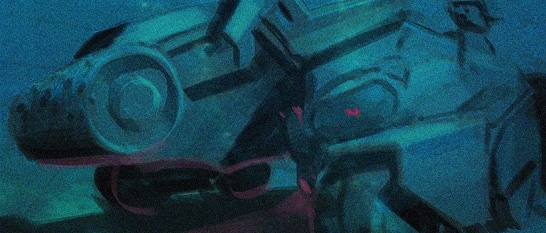
Yet, somehow, Davis looked hopeful.
Noticing this, Park cleared the room of everyone except for her.
“I think it could work, sir,” she said.
“You want me to send Soldiers diving to their deaths on some half-cocked scheme that clearly came from Søndrol, a civilian I met less than two hours ago.”
“That civilian is the expert here, and up the same shit creek we are. He’s offering a paddle.”
“He’s not the one who has to give the order,” Park said.
“Can I speak freely?” Davis asked.
“Please.”
“You’re taking the casualties hard, sir. Harder than you deserve. It’s turned you… risk averse.”
Deep down, Park knew 1SG Davis was right. He let her continue.
“It’s anyone’s game right now. This could tip the scales, sir. Turn a high-friction, evenly matched engagement into one where we’re able to take decisive action. We have a responsibility to the reinforcements, to your Soldiers, and to the mission to try. It’s time to be bold.”
The fog-like dread that had been hanging over him lifted, and Park tapped his neuro-node.ix
“Send Chief Lopez and Søndrol back in, and find our two best swimmers.”
Park shook 1SG Davis’s hand.
“Thanks, Maggie.”
1 HOUR; 20 MINUTES UNTIL REINFORCEMENTS ARRIVE
Park stood with Doc Armstrong, Chief Lopez, and Søndrol in the Strand’s Diver Recovery Area, which housed a ramp that descended into the icy ocean. Søndrol viewed a tablet showing the bulk-cutter’s status and chewed his lip. Park projected calm, but inside he was a live wire.
He glanced at his watch. Two minutes left on the cold protection offered by Lopez’s dive-enhancer. If the bulk cutter hack worked, it would take ten minutes to warm up its engine and fill its ballast tanks so it could rise to ice-level. And then roughly thirty minutes to accomplish its mission. They were cutting it way too close for Park’s liking.
PFC Jenna Gonzalez resurfaced first, exploding from the water with a minute to spare. Chest heaving, she tossed aside her rebreather and collapsed on the floor. Her skin ashen and her lips pale blue. Doc Armstrong pulled her behind a privacy curtain to treat her.
“He sent me up,” Gonzalez gasped from behind the curtain. “It’s not done.”
“Just focus on breathing,” Armstrong said.
The last minute came and went. The estimated period of cold protection was over. Three more minutes passed.
Then Park saw a faint yellow shape rising in the green-blue water. A diving glove. It fluttered, faltering. Without thinking, Park dove in.
The shock of the freezing water was immediate, clamping around his body like a vice. Park fought the crushing sensation and swam to the diver, SPC Logan, with whom Park had knocked helmets in the Stryker. Taking Logan in his arms, he kicked with every ounce of strength he had, and they surged to the surface. SPC Logan spluttered and gasped, and Lopez and Søndrol pulled them onto the ramp.
“The boy did it,” Søndrol crowed, waving his tablet in triumph.
Teeth chattering, Park tapped his neuro-node, which somehow still worked.
“Five, this is Six. Send a secure Q-line to Sunray. Operation Icebreaker is a go.”
3 MINUTES UNTIL REINFORCEMENTS ARRIVE
Park viewed the Mektig BUK-Z99s on-screen in the Strand’s control room, then a projection of the Mektig reinforcement force approaching on the icy plain. The estimated 900 Mektig fighters moved in well-dispersed groups. The control room AR display showed the Mektig air assets circling the airspace above them, the BUKs protecting them from US airborne challengers.
It was a clear day, a blue sky over a white plain, and everything was still.
Kerrrr-ack!
A two-kilometer swath of ice buckled beneath the BUKs, then broke apart and sank into the ocean, taking most of the BUKs with it.
SPC Logan and PFC Gonzalez cheered. They had recovered from their underwater ordeal and sat in the room to see their accomplishment. Lopez and Søndrol shook hands, grinning.
“Timberwolf Six, this is the Taxman,” the commander of the US fighter squadron hailed Park, “Great work. Coming in hot!”
US missiles slammed into the Mektig forces on the ground, and the AR display of the airspace showed US fighters engaging the Mektigs.
Through the haze left by the explosions, the US ground reinforcements appeared near the Mektig flank. The pops of small-arms fire and the booms of the big guns echoed – the ground battle had begun. At the same time, Doc Armstrong and a small team raced a boat out into the ocean with the casualties. A MEDEVAC could now be flown to meet them.
As the Mektigs on the ice fell prey to confusion, Park pressed down the Velcro on his tactical vest and adjusted his rifle strap. Alpha Company was not sitting this one out. Park hailed his company and went out the door with a weapons squad in tow.
“This is Timberwolf Six. We’re taking back this shelf.”
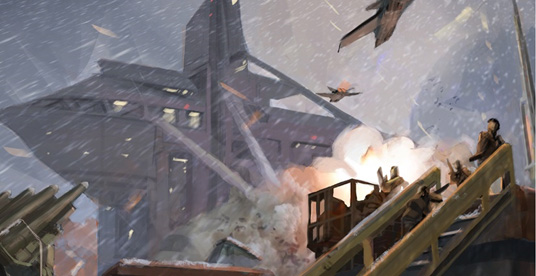
End Notes
i Beneath the facility was a treasure trove of a Rare Earth Element… With China throttling the global REE market, securing viable sources had become a NATO priority:
“Rare Earth Minerals: Developing a Comprehensive Approach Could Help DOD Better Manage National Security Risks in the Supply Chain,” GAO-16-161, Government Accountability Office Report, February 2016,
https://www.gao.gov/assets/680/675165.pdf
James Vincent. “China can’t control the market in rare earth elements because they aren’t all that rare,” The Verge, April 27, 2018, accessed July 12, 2018, https://www.theverge.com/2018/4/17/17246444/rare-earth-metals-discovery-japan-china-monopoly
As of this writing, China produces approximately 90 percent of the world’s supply of rare earth minerals. Rare earth elements are “easy to find” but “difficult to produce” (Vincent). This story posits a future in which the viable veins of certain REEs are scarce, a reasonable projection given the ever-growing global demand for new electronic devices.
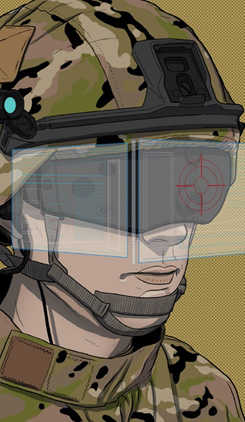
ii Park turned on the Augmented Reality display built into his HUD goggles, and a Picture-In-Picture materialized in the top right corner of his vision:
“SciTech Futures Technology Foresight Game: Bioconvergence and the Soldier of 2050,” Office of the Deputy Assistant Secretary of the Army (Research and Technology), June 11-16, 2018, accessed July 12, 2018, https://futures.armyscitech.com/madscientist/marketplace/
In the SciTech Futures Technology Foresight Game, players were asked to invest virtual money “on behalf of” the US Army, potential future adversaries, and society at large. Augmented Reality / Virtual Reality was a Top 10 idea by investment for the US Army. The player who submitted the idea, ghorstkj, noted that AR/VR needs to be a in the hands of Soldiers for maximum utility, instead of simply being fielded in a Tactical Operations Center or remaining highly developed in the commercial space.
Sydney J Freedberg Jr. “HUD 3.0: Army to test Augmented Reality for Infantry in 18 Months,” Breaking Defense, March 29, 2018, accessed July 12, 2018, https://breakingdefense.com/2018/03/hud-3-0-army-to-test-augmented-reality-for-infantry-in-18-months/
The US Army is developing AR-enabled HUDs for Infantry Soldiers as of this writing.
iii Park had finally been able to reach FOB Nordau with a secure quantum line:
Emily Conover. “A quantum communications satellite proved its potential in 2017,” Science News, Vol. 192, No. 11, December 23, 2017, accessed July 12, 2018, https://www.sciencenews.org/article/global-quantum-communication-top-science-stories-2017-yir
Through impenetrable quantum cryptography, quantum communications could be the next leap forward in secure long-distance communication. If so, militaries would be among the first adopters of such technology.
iv “Reduced heart rate and metabolism buys them time”:
“SciTech Futures… Bioconvergence,” see previous reference.
This is an example of medevac hibernation, a Top 10 idea for Society in the SciTech Futures game. It is a US military capability in this story, as it could have great utility in combat. Submitted by player breakpoint, the idea is that “in the case of grievous wounds, the best option may be to slow the soldier's metabolism and heart rate down as far as possible, trigger vasoconstriction, and wait for rescue.” This could increase first aid effectiveness and decrease blood loss.
Doc Armstrong is a medic in this story (Soldiers call their medics “docs” though they are not MDs), and the grievous wounds suffered by two of his Soldiers are beyond his ability to treat. He puts them in hibernation until they can be MEDEVACed to a higher tier of care.

vWe were able to get a sample from your Soldiers’ bio-filters. It got through the gas masks, by the way:
“SciTech Futures… Bioconvergence,” see previous reference.
User spmorris developed the idea of a symbiotic blood filter, an engineered organism within a Soldier’s bloodstream that detects and removes toxins and foreign bio-agents, creating an additional line of defense against toxins. In this story, this filter caught the enemy microorganism that got through the Soldiers’ gas masks, though the organism only affects petroleum-based fuels.
vi “It’s a bio-engineered microorganism… Gobbles up petroleum-based fuels… That’s why all the vehicles stopped”:
“SciTech Futures… Bioconvergence,” see previous reference.
This is an example of prepositioned biological weapons and supply chain targeted bio-espionage systems, two separate concepts that were both Top 10 ideas for potential future adversaries in the game. As user breakpoint put it, shelf-stable bio-printing, drones and long-life batteries combine to make possible the “creation and emplacement of prepositioned biological weapons that will not appreciably degrade” over years-long timeframes.
User vonbig points out, “microorganisms are capable of breaking tons of materials in the supply chain, converting them into energy and base components. If this could be weaponized or time delayed, contaminants could be used to erase enemy supply chains.” The fictional enemy uses fuel-attacking engineered microorganisms in this story.
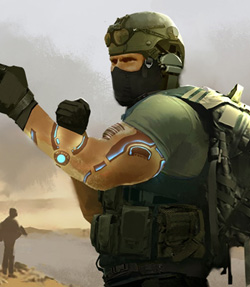
vii “Microchips embedded in the skin that trick artificial intelligences and visual processors. The drone AI classified them as sea lions”:
“SciTech Futures… Bioconvergence,” see previous reference.
Adversarial tattoos fooling AI vision was a Top 10 idea for potential adversaries in the game. The user who developed the concept, datasciburgoon, explains it this way: “Adversarial images are a very recent research idea in computer AI vision. The ability to use small patterns embedded in the skin to fool computer AI vision systems holds a lot of promise. In the future, lethal autonomous weapon systems and automated intelligence gathering systems will use computer AI vision technologies to discriminate between civilian and enemy combatants.” This story shows how an over-reliance on AI in Intelligence, Surveillance, and Reconnaissance (ISR) could be deadly.
viii The same injections that Doc Armstrong used to induce hibernation could, if properly modified, be used to enhance the human dive reflex by reducing pulse rate and oxygen usage. SOCOM was already using this bio-enhancement, Armstrong pointed out:
“SciTech Futures… Bioconvergence,” see previous reference.
Peter Lindholm and Claes EG Lundgren, “The physiology and pathophysiology of human breath-hold diving,” Journal of Applied Physiology, January 1, 2009, accessed July 12, 2018, https://doi.org/10.1152/japplphysiol.90991.2008
Many animals, including humans, have a ‘dive reflex,’ which is a set of physiological responses to immersion. It enables submersion for an extended time by lowering pulse rate, respiration rate, and oxygen usage, redirecting blood to vital organs like the heart and brain. This story, and user breakpoint, posit enhancing this reflex.
In the story, the characters must fashion their own enhancement based on medevac hibernation capabilities, which cause similar physiological responses. In the world of the story, a hardened dive-enhancement capability already exists and is fielded with US Special Operations Command. If or when this capability exists in the real world, Special Operations divers (SEALs, etc) would likely be the first adopters.
ix Park tapped his neuro-node:
“SciTech Futures… Bioconvergence,” see previous reference.
A neuro co-network was a Top 10 idea for both US Army and potential future adversaries in the SciTech Futures Game. The idea is that digital nano-processors and sensors would be integrated into warfighters to co-process sensory perceptions “faster than the brain and then activate sub-conscious” reaction by feeding the brain an “impression” (developed by user k3nsh1n). This would expand by connectivity with other people and their devices/network. This story did not explore this intriguing capability, but did include a “neuro-node” as a nod to such capabilities existing as a normal part of a future Soldier’s life.

Art Credits
Cover: Daniel Brewer
Image 1: Daniel Brewer
Image 2: Daniel Brewer
Image 3: Daniel Brewer
Image 4: Axel Ortiz
Image 5: Scott Carter
Image 6: Mike Gizienski
Image 7: Kirby Leem
Image 8: Mike Gizienski
About the Author(s)
Comments
Wars are part of this world…
Wars are part of this world. Here in this piece of writing, they have predicted about the future wars to let us know about it amazingly and check edubirdie services to finish the academic work. The writer had enough knowledge and has enough skills to portray this story in such a beautiful and interesting way.
